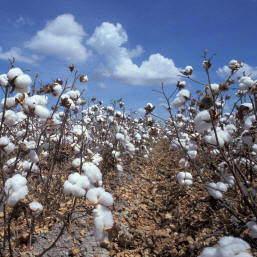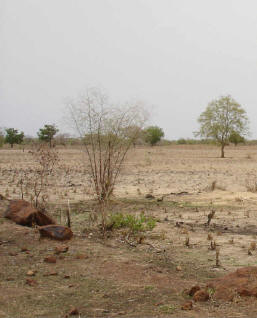Home >>
What we want >>
Desertification >>
Problem Cotton
Problem Cotton
Every human intervention in natural vegetation begins with deforestation and removal of permanent vegetation (trees, bushes, swards). Once the soil has been transferred into farmland it lies barren for half a year without protection.
Intensive sunlight heats the surface to over 60° centigrade. The soil dries up completely and the upper layer becomes crusty. During rain periods the rain can therefore not properly infiltrate into the soil thus increasing the erosion on the fields (water erosion).
In Burkina Faso the areas for planting cotton are being extensively increased: about 1 million ha of all the agricultural areas of about 5 million ha is planted with cotton – with an increasing tendency. The current cultivation system neglects protective measures for the soil and that is why hundred thousands of ha of agricultural area are severely degraded or even completely desertified.
Farming without protection against erosion is generally risky in dry areas, be it for food production (millet) or for growing cotton.
Field with ripe cotton
Cotton however bears higher risks than millet:
Millet
• Millet can grow in the shade and
therefore trees do not have to be removed completely
• Trees prevent wind erosion
• No or only very little use of pesticides, soil organisms remain active
• Crop residues (millet straw) is fed to the animals that supply manure as a side product
• Therefore a good possibility of combining
tillage and livestock breeding
Cotton
-
Cotton does not grow in the
shade; all the trees and bushes including the roots have to be removed -
Strong wind erosion
-
Extensive use of pesticides
that kill many soil organisms (rain worms, termites, others) -
Due to the lack of soil organisms the soil
is not loosened but compressed and rain water can hardly
infiltrate anymore
Growing cotton in Burkina Faso accelerates desertification
In order to grow more cotton, the most fertile soil is occupied preferably or still intact dry forests and savannas are turned into farmland. The current system of growing cotton in Burkina Faso is environmentally harmful and poses a danger for the health of the farmers (excessive and often improper use of pesticides). Even if individual pressure groups are profiting right now, it will be an economical loss for future generations if cotton is grown without protecting the soil and when applying inadequate cultivation measures.
Within only a few years inappropriately grown cotton results in desertification
Environmental friendly cultivation has its price
Cotton can be grown on an environmental friendly basis, but this
requires high investments (protection against erosion, intensive training
and support of farmers) and the readiness of the customers to pay higher
prices for (bio) cotton. In Burkina Faso cotton is currently grown in an
ecologically compatible way on only a few hundred hectares of agricultural
area.
Possible solution with numerical example
Soil conserving measures (stone rows, hedges and trees for protection
against the wind, etc) must be supported by public funds. The larger part of
such investments is achieved by the farmer’s work. If the agricultural areas,
where cotton is cultivated, are to be protected effectively against
degradation, about 150 EUR as subsidies are required per ha – or for the
whole country a total of 150 million EUR. These one-time investments should
be terminated within 5 years. The annual financial requirements thus amount
to about 30 million EUR.
Consultation of farmers
The introduction of an environmentally friendly cultivation of cotton is
demanding, time consuming and additionally requires approx. another 10.000
agricultural advisors. The annual costs amount to about 30 million EUR and
would also have to be subsidized.
High expenditure of work
The farmers must either be paid more money for their additional efforts,
or they should only be allowed to cultivate cotton, if they adhere to the
respective criteria for growing cotton (difficult to implement).
Conclusion
Because the state does not have the necessary money to finance the
subsidies of annually 60 million EUR (during the 5 years) and 30 million EUR
(for the following years), the money would have to provided by the different
donating organizations (World Bank, IFAD, bilateral donors, others) as
credits or grants. This would be an increase of 20% of the public
development aid within 5 years or a respective shifting.
The final consumer of cotton products can support the change to environmental friendly cotton cultivation by buying bio products.

